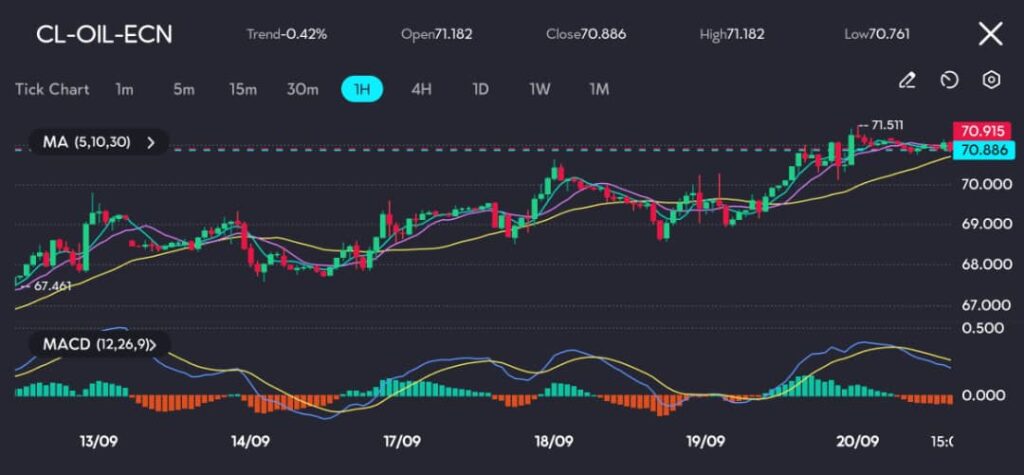Key points:
- Brent futures are up 4.3% this week, with US WTI crude rising by 4.8% over the same period.
- US crude inventories hit a one-year low, contributing to higher prices despite weak Chinese demand.
Brent futures, which were trading down 26 cents or 0.4% at $73.62 a barrel early on Friday, have still gained 4.3% over the week. Similarly, US WTI crude registered a 4.8% rise for the week.

See: WTI oil prices on the rise, trading at 70.915 on the VT Markets app.
Crude oil prices have seen a marked recovery following a dip near three-year lows on 10 September. Since then, the market has posted gains in five of the past seven sessions, pushing the price to a high of $71.18 before closing at $70.88.
On the hourly chart, oil prices have been fluctuating around the 30-period moving average, with the MACD line remaining slightly above the signal line, indicating a continuation of bullish momentum. The $71.51 resistance level, reached earlier, remains a key area to watch for potential upside movement. If prices manage to break above this level, we could see further gains toward the $72.00 mark.
However, immediate support lies near the $70.50 level, as seen in the confluence of the 10-period and 30-period moving averages. A break below this could signal a short-term pullback toward $70.00, where stronger support is expected to cushion any declines.
Oil prices dip after Thursday’s surge despite rate cut boost
We saw oil prices lose some ground on Friday, pulling back after a surge of over 1% on Thursday. The boost came in response to the US Federal Reserve cutting interest rates by half a percentage point on Wednesday. Such moves typically stimulate economic activity, which tends to raise energy demand. However, some market participants remain cautious, interpreting the rate cut as a sign of softness in the US labour market.
The decline in US crude inventories, which fell to their lowest level in a year, is another factor helping to lift oil prices. A supply deficit of approximately 400,000 barrels per day is expected to support Brent crude within the $70 to $75 range through the next quarter. Nonetheless, there is caution in the air, with the possibility that prices could fall in 2025, highlighting future market uncertainty.
Previously, in case you misse: Oil prices surge on rate cut hopes, but demand worries linger
Middle East tensions stir uncertainty in oil markets amid supply concerns
Geopolitical tensions have also been influencing the market. In the Middle East, explosions involving Hezbollah’s communication equipment raised concerns earlier this week. While security sources have pointed fingers at Israel’s Mossad, officials have yet to comment, leaving an air of uncertainty about potential impacts on oil supply routes.
China’s slowdown raises concerns over future oil demand and prices
Meanwhile, China’s economic slowdown is acting as a drag on oil demand. Refinery output has been declining for five consecutive months, while industrial production growth in the country reached its lowest in five months.
Additionally, retail sales and new home prices have shown further weakness, reinforcing concerns about China’s economic outlook. As one of the largest importers of oil, any sustained slowdown in Chinese demand could weigh on global prices in the coming months.
The market will likely remain focused on how the balance between US economic conditions, geopolitical risks, and Chinese demand evolves in the near term. While the rate cut has supported prices in the short run, weaker demand from China and Middle East tensions could complicate the outlook for oil prices moving forward.
Start trading now — click here to create your live VT Markets account.









